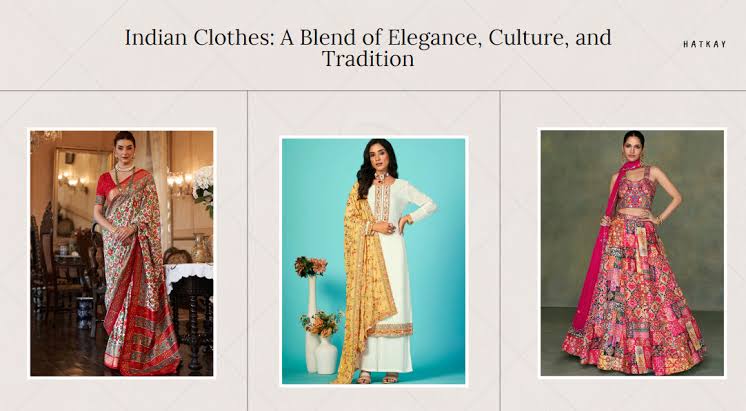India, a land known for its rich cultural diversity, is equally remarkable when it comes to its traditional attire. The clothing worn by the people of India is a reflection of the country’s vast and diverse culture, history, and customs. Clothing in India is not just about modesty or fashion; it is a representation of regional identities, community rituals, and the essence of Indian life. From the simple elegance of a saree to the grandeur of a lehenga choli, from the subtle beauty of a salwar kameez to the dignified appearance of a sherwani, every traditional dress carries with it a unique history and profound cultural significance.
In this blog, we will explore the fascinating world of traditional Indian dresses, diving deep into their origins, evolution, regional variations, and the reasons why these garments continue to thrive even in the modern world. Whether it’s the elegance of the saree or the regal charm of the sherwani, we will journey across India’s diverse regions and understand the beauty of its attire.
1. The Saree: Timeless Elegance and Versatility
The saree is often considered the most iconic and enduring piece of traditional attire in India. It has been worn by women for thousands of years and is still one of the most popular forms of clothing for women across the country, especially during festivals, weddings, and ceremonial occasions. The saree is a long, unstitched piece of cloth, typically measuring around 5 to 9 yards, which is draped around the body in various styles.
The Historical and Cultural Context of the Saree
The history of the saree can be traced back to the Indus Valley Civilization, making it one of the oldest forms of clothing in the world. Archaeological evidence suggests that women in ancient India wore garments similar to the saree, draping cloths around their bodies in a graceful manner. Over the centuries, the saree evolved, influenced by changing fashion trends, rulers, and cultural exchanges.
The saree is not just a garment; it is a symbol of Indian femininity, grace, and cultural heritage. In ancient India, it was associated with modesty and was considered a mark of a woman’s status and dignity. Today, it continues to be a symbol of beauty, elegance, and national identity, worn by women from all walks of life, including celebrities and politicians.
Regional Variations of the Saree
The saree’s draping style and fabric vary significantly across India, with each region having its unique interpretation of this classic garment. Some of the most famous types of sarees include:
Kanjivaram Saree (Tamil Nadu): Known for its luxurious silk fabric, the Kanjivaram saree is one of the most prestigious types of sarees in India. Worn by brides and women on special occasions, this saree features intricate motifs and patterns, often using gold and silver zari (thread work).
Banarasi Saree (Uttar Pradesh): Banarasi sarees are known for their opulent designs, intricate brocade work, and gold or silver zari. Worn during weddings and festivals, these sarees have a regal appeal, and the city of Varanasi is synonymous with these beautiful creations.
Chanderi Saree (Madhya Pradesh): Lightweight and elegant, the Chanderi saree is made from a blend of silk and cotton, giving it a unique transparency. Known for its subtle and artistic motifs, this saree is popular among women who seek comfort without sacrificing style.
Bandhani Saree (Rajasthan and Gujarat): Bandhani sarees are characterized by their bright colors and traditional tie-dye patterns. Often worn during festivals and celebrations, these sarees are a symbol of vibrancy and are highly prized for their intricate designs.
Tant Saree (West Bengal): Famous for its lightweight fabric, often made from cotton, the Tant saree is known for its elegant simplicity. It is traditionally worn by Bengali women during weddings and festive occasions and is prized for its comfortable and breathable nature.
The Art of Draping
One of the most fascinating aspects of the saree is its draping style. The way a saree is draped varies greatly across India, and the draping method often indicates the region of the wearer’s origin. Some of the most popular draping styles include:
Nivi Draping: The most common draping style, popular in Southern and Western India, involves pleating the saree at the waist and draping it over the shoulder.
Bengali Draping: In this style, the saree is draped around the body in such a way that the pleats are at the back, and the pallu (the end of the saree) is thrown over the left shoulder.
Maharashtrian Draping: The saree is draped in a distinctive style with a fan of pleats at the back and the pallu pinned at the shoulder, often worn with a traditional headpiece or “nath.”
2. Salwar Kameez: The Symbol of Comfort and Practicality
The salwar kameez is one of the most popular and versatile traditional outfits for women in India. Consisting of three main components—the kameez (tunic), salwar (trousers), and dupatta (scarf)—this outfit is known for its practicality, comfort, and elegance. The salwar kameez has become a favorite for everyday wear, office attire, and even special occasions.
Evolution and Popularity
The salwar kameez finds its origins in Central Asia and Persia, where it was adopted by Mughal rulers and their court. The outfit became widely popular among women in northern India and Pakistan during the Mughal era and continues to be a staple in modern-day fashion. Over time, the salwar kameez evolved, with various regional and cultural variations that reflect the diversity of Indian fashion.
Today, the salwar kameez is worn across the country, and its popularity has only increased, especially with young women seeking a combination of comfort, style, and modesty. The ensemble can be worn in various fabrics, ranging from cotton for daily wear to silk and chiffon for festive occasions.
Regional Variations of the Salwar Kameez
The salwar kameez comes in many forms, each suited to the regional tastes and climate of the area. Some notable variations include:
Patiala Salwar Kameez (Punjab): The Patiala salwar is a traditional, heavily pleated, and baggy style of trousers. This style is paired with a short or long kameez and is often worn during festivals or weddings.
Anarkali Suit (North India): Characterized by a long, flowing kameez with a fitted bodice, the Anarkali suit is a popular choice for formal and festive occasions. This style draws its name from Anarkali, the famous Mughal courtesan, and is known for its regal and dramatic look.
Churidar Salwar Kameez (North India): The churidar features tight-fitting trousers that gather at the ankle. Paired with a straight or Anarkali kameez, the churidar is a popular and stylish choice for various occasions.
Kashmiri Salwar Kameez (Kashmir): The Kashmiri version is made of luxurious fabrics such as wool and features intricate embroidery, often in floral designs. The outfit is ideal for the chilly winters of Kashmir and is often worn during religious festivals.
Gujrati Style Salwar Kameez (Gujarat): The Gujarati version features brightly colored fabrics and often includes mirror work, bandhani (tie-dye) patterns, and intricate embroidery. This style of salwar kameez is often worn with a dupatta draped over the head or shoulders.
3. Lehenga Choli: The Bridal and Festive Splendor
The lehenga choli is one of the most iconic traditional garments worn by women during weddings, festivals, and special ceremonies. This elegant outfit consists of a long, flared skirt (lehenga), a fitted blouse (choli), and a dupatta or scarf.
The Origins of the Lehenga Choli
The lehenga choli traces its roots back to the royal courts of Rajasthan and Gujarat, where it was initially worn by queens and noblewomen during ceremonial occasions. Over time, the lehenga choli evolved into a popular choice for brides and women attending weddings and festivals.
Today, the lehenga choli is synonymous with bridal fashion and is considered one of the most opulent and luxurious garments in India. It is often made from luxurious fabrics such as silk, velvet, and brocade, and is embellished with intricate embroidery, sequins, and beads, making it a popular choice for weddings and other grand occasions.
Regional Variations of the Lehenga Choli
Rajasthani Lehenga: Known for its vibrant colors and rich embroidery, the Rajasthani lehenga is often paired with heavy jewelry and a dupatta that covers the head and shoulders. The lehenga may feature traditional motifs such as peacocks, elephants, and floral designs.
Gujarati Lehenga: The Gujarati lehenga is bright, colorful, and decorated with mirror work and bead embroidery. This style is often worn with a short, fitted choli and a dupatta draped elegantly over the shoulder.
Maharashtrian Nauvari Saree: A variation of the lehenga, this traditional outfit is worn by women in Maharashtra, particularly during weddings. It is a nine-yard saree draped in such a way that it resembles a lehenga, often paired with a blouse and headpiece.
4. Sherwani: The Epitome of Men’s Formal Wear
The sherwani is the traditional formal wear for men, often worn during weddings, festivals, and special ceremonies. A knee-length coat with intricate embroidery and embellishments, the sherwani is considered the male counterpart to the lehenga choli and is associated with royal and dignified appearances.
The Historical Context of the Sherwani
The sherwani has its origins in Persia and Central Asia, introduced to India by Mughal rulers in the 16th century. It became a staple in the Indian subcontinent during the Mughal Empire and was worn by men of nobility, royalty, and elites. The sherwani was designed to be both regal and practical, providing comfort while maintaining a grand appearance.
Regional Variations of the Sherwani
Mughal Sherwani: The Mughal-inspired sherwani is known for its fine fabric, gold or silver embroidery, and rich colors. It is often worn by grooms on their wedding day and features intricate designs like paisleys, florals, and geometric patterns.
Achkan (North India): Similar to the sherwani, the achkan is a slightly shorter coat, often worn in a more understated style. It is typically paired with a churidar or slim trousers.
Pathani Suit (North India): While not exactly a sherwani, the Pathani suit is a traditional outfit worn by men in the northern regions of India. It features a long tunic-like kurta with matching pants, often worn with a cap or turban.
5. Kurta-Pajama: The Classic Casual Elegance
The kurta-pajama is a traditional outfit worn by men across India. It consists of a long tunic (kurta) and loose-fitting trousers (pajama). Known for its comfort and elegance, the kurta-pajama is a staple in the wardrobes of Indian men and is often worn for casual gatherings, religious ceremonies, and even formal occasions.
The Simplicity and Versatility of the Kurta-Pajama
The kurta-pajama is known for its simple yet elegant appearance. It can be made from various fabrics, including cotton, linen, silk, and wool, making it suitable for all seasons. The kurta can range from simple and plain to intricately embroidered, while the pajama is usually a relaxed, flowing garment that allows ease of movement.
Regional Variations of the Kurta-Pajama
Punjabi Kurta-Pajama: Often worn by men in Punjab, this version of the kurta-pajama is characterized by its vibrant colors and simple designs. It is typically paired with a turban or “pagri” as a sign of respect and tradition.
Maharashtrian Kurta-Pajama: Worn with a simple, sober design, the Maharashtrian kurta-pajama is often worn with a “topi” (cap). This attire is ideal for casual wear as well as festive occasions.
6. Dhoti: The Traditional Attire of the Indian Man
The dhoti is one of the oldest and most traditional garments worn by men in India. A rectangular piece of cloth, usually 5 to 6 yards in length, the dhoti is wrapped around the waist and tied in place, traditionally worn with a kurta or shirt. The dhoti symbolizes Indian masculinity and is commonly worn during religious ceremonies, weddings, and festivals.
The Cultural Significance of the Dhoti
The dhoti is not just an article of clothing; it is a symbol of simplicity, humility, and spiritual purity. Historically, the dhoti was the everyday attire of men across India, from peasants to royalty. Today, it remains an integral part of traditional attire, especially in rural areas and during religious ceremonies.
Regional Variations of the Dhoti
Maharashtrian Dhoti: Known for its distinctive draping style, the Maharashtrian dhoti is often worn with a kurta and accompanied by a “nath” (nose ring) or “mundavalya” (a decorative thread).
Telugu Dhoti: The dhoti worn in Andhra Pradesh and Telangana is typically paired with a shirt or vest and tied in a specific style unique to the region.
7. Lungi: The Comfort Wear of the South
The lungi is a simple piece of cloth wrapped around the waist, worn mostly by men in the southern states of India, especially in Tamil Nadu, Kerala, and Andhra Pradesh. Known for its comfort, the lungi is ideal for hot and humid climates and is often worn during casual activities or at home.
The Versatility of the Lungi
The lungi is both practical and economical. It is made of cotton, which is breathable and comfortable, making it ideal for hot weather. Although it was once seen as a purely rural garment, the lungi has gained acceptance in urban areas as well, especially in informal settings.
Conclusion
The traditional clothing of India is a celebration of the country’s rich history, diverse culture, and vibrant regional identities. From the timeless elegance of the saree to the regal grandeur of the lehenga choli, from the simplicity of the kurta-pajama to the classic sophistication of the sherwani, each garment tells a unique story about the people who wear it. India’s vast cultural heritage is beautifully reflected in its clothing, which continues to evolve while preserving its deep-rooted traditions.
Each dress, whether it is the saree, salwar kameez, or sherwani, carries with it centuries of history, art, and craftsmanship. While fashion trends change, the significance of traditional Indian attire remains timeless, providing a window into the country’s soul. As modern fashion continues to influence the traditional styles, Indian clothing remains a symbol of cultural pride, craftsmanship, and identity.
Through its clothing, India’s diversity, craftsmanship, and heritage are preserved, allowing future generations to connect with their past while embracing the present. Whether worn during festivals, weddings, or daily life, traditional dresses in India are not just garments—they are expressions of history, culture, and personal identity.


